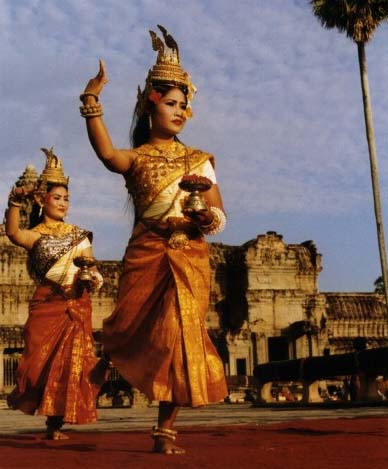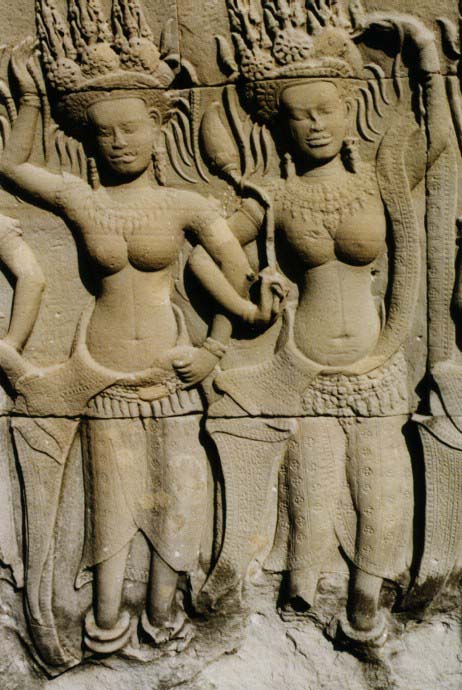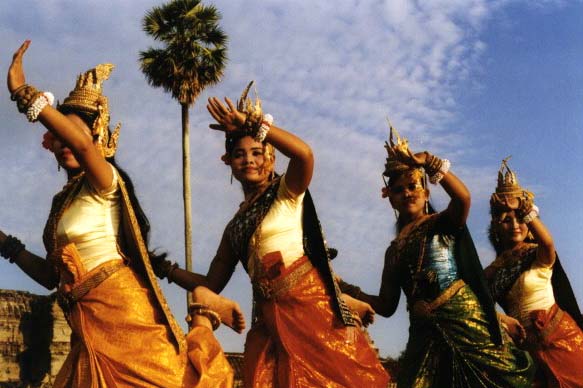
Angkor Wat and the Khmer Dancers
 |
| Apsara Dancer, Angkor Wat |
After a quick shower at the hotel, we decided to check out the market down the street. Across the dusty dirt road and down about a block, we found the open air market. Dozens of merchant stalls sat under a large tent. The whole market was no bigger than a small city block. Fish mongers displayed their products in piles (not as if they had to, the smell was advertisement enough). We walked under the tent and into the maze of stalls. Many of the merchants rested in hammocks. One young merchant fell asleep on a glass cabinet full of watches. A woman sat at a cloth stand and rocked an infant in a hammock. Women sold miniature figures of the Bayon heads, wood carvings of the Angkor sites, paintings of Angkor Wat, charcoal rubbings of the bas reliefs. An elderly book seller stood in front of his collection: "Pol Pot: Brother Number One" "The Tragedy of Cambodian History," and other Khmer Rouge era studies.
We hurried back to the hotel and met Rang. Refueled and rested we went directly to Angkor Wat. Rang said we could meet him at 4:40PM, and we'd drive to Phnom Bakheng, a hill where we could watch the sun set. We waved good-bye to him and started down the stone bridge that spanned across the moat.
Angkor Wat is Cambodia's signature piece. Historians believe it was built during the reign of Suryavarman II (1112 - 1152 AD) to honor the Hindu god Vishnu and to serve as a funerary temple for the king. The details are incredibly well preserved. The most significant features of the wat are oriented towards the west which is traditionally the direction of death. Like many temples in Angkor, the highest tower represents Mount Meru
are oriented towards the west which is traditionally the direction of death. Like many temples in Angkor, the highest tower represents Mount Meru , the Hindu mystical center of the universe. The surrounding towers represent the lower mountains.
, the Hindu mystical center of the universe. The surrounding towers represent the lower mountains.
 |
| Angkor Wat |
 |
| Bas relief detail, Angkor Wat |
Finally we reached the pinnacle of Angkor Wat. We circled the level and looked out at the view, then we lit incense at the shrine of a reclining Buddha. On its way out the window, the smoke drifted past a saffron cloth twisted around a chunk of stone. Three children sat under the shade of the temple playing a game with marble sized stones. We rested for a while at the top, met other tourists from Washington, D.C. and Australia, then we went back down the way we came. From a few feet back, it looked as if the staircase dropped off like a cliff. In truth, going down was ten times easier than going up. A group of nuns were gathered at the base of the stairs like a sort of congratulatory committee.
 |
| Preparing for the dance |
 dancers preparing for a show. The covered entrance was their dressing room. Teenage girls prepared their elaborate stupa
dancers preparing for a show. The covered entrance was their dressing room. Teenage girls prepared their elaborate stupa -like headpieces and adjusted their golden sequined costumes. Younger girls put on lipstick and red rouge. One of the girls giggled as I took her picture. Boys smeared white paint on their faces and applied lip color. A dog wandered around sniffing at the costumes and makeup. Little children from all over the park gathered around the dancers. They rested their elbows on the ground and pressed their palms against their cheeks and watched the backstage frenzy. Young performers tried on their plaster masks, painted to look like the Hindu monkey god Hanuman and his crew.
-like headpieces and adjusted their golden sequined costumes. Younger girls put on lipstick and red rouge. One of the girls giggled as I took her picture. Boys smeared white paint on their faces and applied lip color. A dog wandered around sniffing at the costumes and makeup. Little children from all over the park gathered around the dancers. They rested their elbows on the ground and pressed their palms against their cheeks and watched the backstage frenzy. Young performers tried on their plaster masks, painted to look like the Hindu monkey god Hanuman and his crew.
 |
| Apsara dancers perform the petal dance (Hear the dance in RealAudio!) For more scenes from the performance, visit The Children of Southeast Asia |
 |
| Cambodian boy as Hanuman, the Monkey God Listen to his dance with RealAudio! |
The whole time we were a little worried because this unexpected event was making us very late for Rang. As soon as the performance ended, we hurried back across the field, over the causeway and down the steps to Rang. He didn't seem surprised that we were so late. We decided it was too late to climb up the hill to catch the sunset, so we headed back to the hotel. We ate fried rice at a local restaurant called the Singapore. Christmas lights were strung all over the outside of the restaurant... in the bushes, across the awning. Geckos scampered across the walls, Cambodian TV played in the hallway, and friendly locals drank and laughed at the next table.
 |
 |
 |
|
previous journal |
journal index |
next journal |